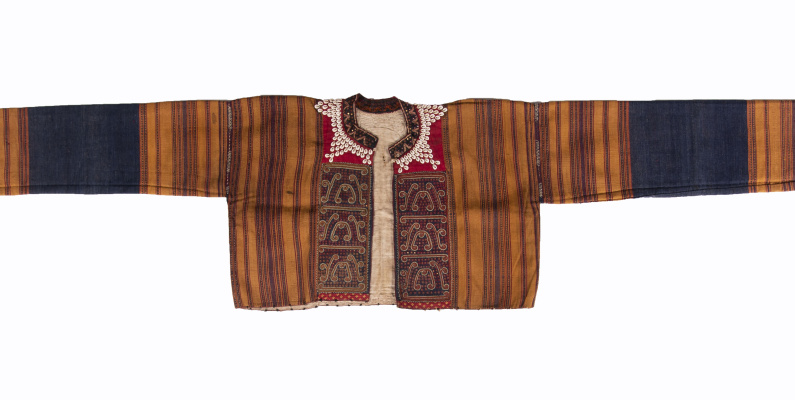
Kauer woman’s cotton jacket with embroidered motifs, small mirror pieces (cermuk), and stitched sections of shell;Lampung area of Sumatra.
D2021.22 Margery Blackman Textile Collection; Tūhura Otago Museum Collection
We’ve had the great pleasure of seeing the collection of textiles assembled by Margery Blackman, QSM, on display in our People of the World gallery for the past couple of years the exhibition, “it’s all in the making”, a phrase Margery used when describing her point of fascination with these pieces. While it was always going to be a fixed-term exhibition, and even knowing that the pieces will remain here, having all been generously donated to the Museum by Margery, I’m still a little sad when I contemplate the de-installation of the exhibition in October.

Corner detail of embroidered cushion cover; Indus Kohistan, northwest Pakistan.
D2021.20 Margery Blackman Textile Collection; Tūhura Otago Museum Collection
Margery grew up in Christchurch but was born in Dunedin in 1930, when her father, Lance McCaskill, was a lecturer in agriculture and biology at the (then) Dunedin Training College. She is a graduate of the Home Science Faculty at the University of Otago, and taught high school classes for a time before her marriage to Gary Blackman. During their more than 60 years of shared family life and interests, Margery’s own reputation as a weaver and a tapestry maker developed. So, too, did her interest in textiles created elsewhere in the world. The exhibition at Tūhura Otago Museum is of work by other makers – most often anonymous women – that she recognised, researched and valued, as her knowledge and opportunities grew.

Korjin – finely woven Baluch double-pouch saddlebag; Iran.
D2021.13 Margery Blackman Textile Collection; Tūhura Otago Museum Collection
During the years in which she was Honorary Curator of ethnographic textiles here, Margery curated an exhibition of Chinese garments from our collection and, with help in the form of Gary’s graphic design skills, authored a still-sought-after catalogue of it. She also studied in detail the construction techniques of Māori textiles – particularly kākahu – held in collections in Aotearoa and elsewhere around the world. Her own acquisitions, however, focussed in the main on work from West Asia and Indonesia, areas from which the Museum’s collection had fewer examples.

Batik selendang, or head/shoulder cloth; Sumatra.
D2021.17 Margery Blackman Textile Collection; Tūhura Otago Museum Collection
Annah Taggart is the talented designer behind “it’s all in the making”. She developed a concept for the layout that maintained professional standards for object safety while still allowing visitors to have a close view of these lovely pieces. Annah also designed the touch screens, arranged for the text panels to be printed on fabric, and planned the other details that made the exhibition an enjoyable space in which to spend time.

Detail of child's beaded and embroidered headwear; northwest Pakistan.
D2021.35 Margery Blackman Textile Collection; Tūhura Otago Museum Collection
Margery participated fully in the preparations: she was shown plans for and approved the groupings, the layout, and the labels. I used to deliver printouts to her home in the evenings after work and would visit a day or two later to collect them. We would sit down to discuss progress, and Margery would explain any comments or alterations she had made. We planned an afternoon tea ‘opening’, but sadly that went the way of so many social events once COVID-19 was in our community.

Bag woven by the Shahsavan people; northwest Iran.
D2021.31 Margery Blackman Textile Collection; Tūhura Otago Museum Collection
The collection contains work made and decorated by a range of techniques.
There are examples of embroidery and different weaving techniques; of batik and ikat patterning; and of the use of silk, cotton, and wool fibres. Pieces made for a variety of purposes are included, such as garments, bags, and practical domestic pieces.

Embroidered cap; Central Asia.
D2021.50 Margery Blackman Textile Collection; Tūhura Otago Museum Collection
There areitemsMargerypurchasedin Dunedin and while travelling, and gifts from family and friends. Gary would occasionally return home from study or conference trips with something he thought would appeal; her daughter purchased an uncut double ikat when she visited the village of Tenganan in eastern Bali on holiday; and friend and embroiderer Gay Eaton bought a small suzani on Margery’s behalf when she participated in a Silk Road tour.

Lower edge detail of ikat selendang/shoulder cloth given to Margery by Rodney Kennedy; Savu, Indonesia.
D2021.6 Margery Blackman Textile Collection; Tūhura Otago Museum Collection
Ultimately, this generous gift will help the Museum better illustrate how textiles are intimately connected to the day-to-day survival and longer-term identity of the communities whose members use and wear them, as well as to the skilled work of the women who typically produced them. And it shows Margery’s thoughtfulness in considering how to share her passion for textiles with her own Otago community.
There’s still time to see it – the exhibition will be on display until 5pm, Sunday 15 October.
